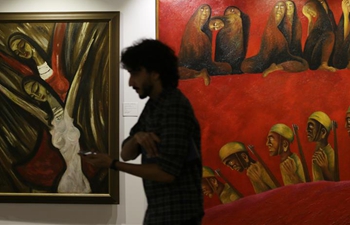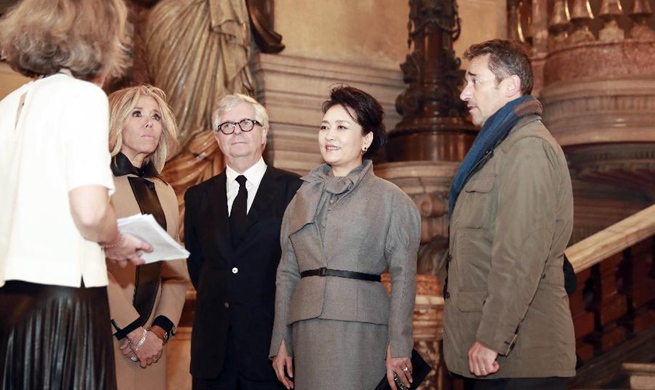NEW YORK, March 25 (Xinhua) -- It looks like a normal six-string electronic guitar. But after Li Shuyu and Chase Philpotts fiddled with some little secret parts on it, the guitar magically split in half, creating two three-string "baby guitars" that could be played by two to make the same wonderful music.
This special guitar, named "Splita," was invented by Li and Philpotts, both second year graduate students majoring in Industrial Design at the New York City-based Pratt Institute's School of Design, dubbed a "cradle" of modern elite designers. The young men spent a month on designing and making the piece, before presenting it at a mini-concert held in their department weeks ago.
"We surprised our fellow students a little bit when we tore the guitar apart," said Li, 28, at his department's workshop on Pratt's Brooklyn campus. "You know, that's what we want to achieve."
On the other side of the room, 24-year-old Hong Sisi was playing on her lap a crescent-shaped wooden instrument. Hong said it's an adapted Kalimba, an African instrument which originally looks like a small cutting board with over a dozen metal pieces as keys attached to it.
Although Hong's work is several times bigger than a normal Kalimba, she said it's actually easier to handle than the original version. "I care about the ergonomics in designs," said Hong, who can play the piano, Guzheng (a traditional Chinese string instrument) and bass. "For example, violin players may suffer from shoulder pains because of the orthodox way to hold the instrument. My Kalimba enables the musician's arms to be placed in a more natural way."
The room was crowded with youngsters like Li and Hong, who were displaying their creative works ranging from more wearable shoes, 3D-printed chocolates to furniture that can also function as decorations. Nearly half of the students came from China.
Though it's very competitive to enter the program at Pratt, a growing number of Chinese students have been enrolled in recent years, Constantin Boym, chairperson of Pratt's Industrial Design Department, told Xinhua while making a random inspection at the studio.
"We very much appreciate the Chinese students here because of their skills, the quality of their work and their attitude," said Boym, pointing at a stockpile of creative designs. "Things are done in such a meticulous way that, you know, it gives me much pleasure."
As more Chinese students come to study in the United States, their choices of majors have expanded from natural sciences that often promise a good career, to a wider spectrum that includes arts and design, which used to be dominated by Western talents.
This trend has also been seen in the area of fashion design, where some freshly graduated Chinese designers have started to gain a foothold in top global arenas. During the latest New York Fashion Week (NYFW), nearly a dozen young Chinese talents held runway shows for their self-developed brands, a stunning growth in number compared with just five years ago.
Leaf Xia, who made her debut at the NYFW in early February, is a typical example. Born and raised in China, Xia graduated from the New York-based Parsons School of Design in 2015 with a Bachelor of Fine Arts before going back to Shanghai to launch her eponymous brand. She has been invited to hold runway shows for three times at the London Fashion Week, another global fashion extravaganza.
Xia's show sprang up as the cutest one of the two-week long New York event, as models holding Hello Kitty dolls turned the runway into a teenage girls' party full of pinky colors, sweet smiles and vibrant strides, melting even the coldest poker faces sitting on the benches.
In a backstage interview with Xinhua, 26-year-old Xia said that an array of Parsons alumni from China have thrived in the industry, such as Calvin Luo, who became the youngest designer to present works at the NYFW's 2018 Spring/Summer edition and also won wide acclaim.
"In my opinion, this is something that's meant to be happening," said Xia, pointing to the fact that an ever increasing number of Chinese students studying abroad have chosen to learn design.
Xia attributes the phenomenon to the rapid economic growth and social development in China in the past decades, which enabled more students to chase their dreams just for passion and aspiration, instead of a stable job. "In the past, a lot of brilliant Chinese students majored in maths, but as the country develops, more talent in art will emerge," she noted.
"We Chinese are born with the desire to excel, and we have a great taste in art owing to the long history and rich culture of our country," she added.
Now Xia has settled in Shanghai, which she sees as a good place to do her branding. Hong at Pratt also plans to develop her future career back in China because of its burgeoning design industry and market.
"I can see the progress of design in China especially on culturally creative industries, like those developed by the Palace Museum (in Beijing)," said Hong, referring to the souvenirs sold at the museum's gift shop that have captivated millions of visitors in recent years. From lipsticks with Chinese paintings, to "princess-style" necklaces and earrings, many of the items were immediately sold out at the museum's online shop once released.
Such designs are not simply making things more beautiful, said Hong, but have added a strong cultural connotation to the otherwise-common products.
Hong believes there are still "infinite possibilities" for Chinese designs, and she wants to take a full advantage of the knowledge and experience she gained at Pratt.
"As more and more people are talking about 'created in China' rather than 'made in China,' I hope I can find the opportunity to do my little part in boosting China's design industry," said the young designer.

















